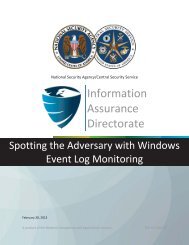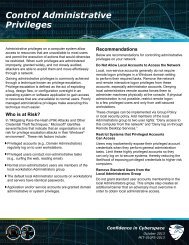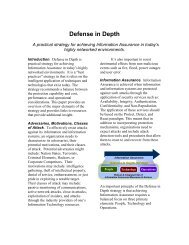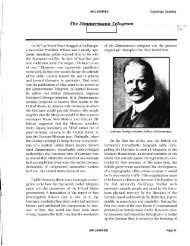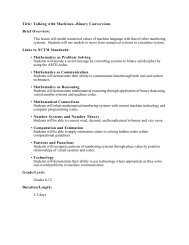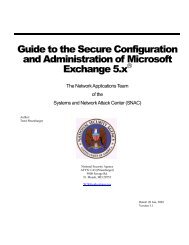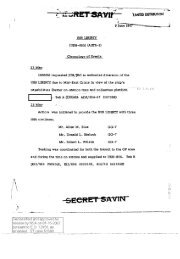CRYPTOLOG - National Security Agency
CRYPTOLOG - National Security Agency
CRYPTOLOG - National Security Agency
Create successful ePaper yourself
Turn your PDF publications into a flip-book with our unique Google optimized e-Paper software.
DOCID: 4009690 'FOP SECRE'F lHtlBR-A<br />
realizing the growth potential of public cellular communications<br />
and a need for standardization among these<br />
systems, established the GSM Working Group. Specifically,<br />
it was tasked to provide an outline definition by<br />
December 1986 and a specification for a Pan-European<br />
public land mobile network by December 1988. Early<br />
in 1983, the working group had identified all competing<br />
systems and proposals, none of which were acceptable<br />
as candidates for the Pan-European system. To avoid<br />
standardization obstacles and any interference with the<br />
development of a new, clearly defined Pan-European<br />
system, the working group declared that all existing systems<br />
and system proposals would be considered<br />
"interim" systems.<br />
(V) In 1987 the Ministerial Council of the European<br />
Community (EC) urged all member countries to<br />
introduce the GSM system. According to this recommendation,<br />
the start date for the Pan-European digital<br />
cellular mobile radio system should be no later than<br />
1991, the most important city areas should be covered<br />
no later than 1993, and the main connections between<br />
covered areas should be no later than 1995. This recommendation<br />
was adopted in 1987 through a memorandum<br />
of understanding (MoV) between operators and telecommunications<br />
administrators of 16 European<br />
nations. Since then, others have signed the MoV, bringing<br />
the total number of signatories to 23 operators in 16<br />
European countries, as well as another 20 countries<br />
throughout the rest of the world. Most of these countries<br />
have agreed to abide by the terms of the EC recommendation<br />
including the stipulation to license at least<br />
two operators, one private and one public, thereby creating<br />
a competitive consumer market.<br />
(V) As the GSM working group's activities progressed,<br />
it became quite apparent that the analog systems<br />
currently deployed in Europe were overburdened<br />
and would be unable to meet future demand for public<br />
mobile cellular communications. Therefore, in 1987, it<br />
modified the GSM system specifications, citing a<br />
change from analog to digital technology. Since 1989,<br />
when the program was transferred from CEPT to ETSI,<br />
work on the GSM standard has continued as planned,<br />
and CEPT continues to provide an open meeting place<br />
for European telecommunication standardization activities.<br />
It should also be noted that, although CEPT and<br />
ETSI have been the overseers of the GSM program, various<br />
ad-hoc subgroups and joint groups have been<br />
formed periodically to assist in the development of the<br />
GSM standards. At one time there were as many as 28<br />
groups involved in the writing ofthe standard, as well as<br />
the theoretical, practical, and simulation studies associated<br />
with the program.<br />
'FOP SECRE'F mtBRA<br />
IMNBLE VIA COIt.UNF CIIAM'ffiLS ONL¥<br />
Why was GSM developed?<br />
CRVPTOLOG<br />
July 1994<br />
(V) Development of GSM is particularly important<br />
at this time, due to the political and economic changes<br />
sweeping the world today. Many of the Third World<br />
countries (including those in East Europe), are attempting<br />
to develop market economies patterned after those<br />
of the West, to which efficient communications are<br />
essential; therefore, many of these countries are planning<br />
massive upgrades of their telecommunications<br />
infrastructures and are intent on deploying state-of-theart<br />
equipment in order to compete.<br />
(V) Funding for such upgrades, if not nationally<br />
available, is in most instances readily available through<br />
various lending institutions like the International Monetary<br />
Fund and the European Bank for Reconstruction<br />
and Development, or through joint ventures with many<br />
western companies designing and building GSM-compatible<br />
equipments.<br />
(V) Various factors have driven the development<br />
of the GSM system, but probably the most important of<br />
these was the need to develop a standard to be adhered<br />
to by all digital mobile communications equipment<br />
manufacturers and suppliers. This standard will insure<br />
compatibility between equipment and provide a capability<br />
for the user to roam freely throughout Europe while<br />
maintaining communications with another party, be it<br />
through speech or data.<br />
(V) Another major factor was the phenomenal<br />
growth in the use and deployment of public analog cellular<br />
mobile networks. Several European countries, as<br />
early as 1983, had deployed mostly non-compatible systems<br />
operating in the 450MHz band. This rapid growth,<br />
especially in the Nordic countries, resulted in pressure<br />
to allow these systems to migrate operationally into the<br />
900MHz band-a logical migration, since the International<br />
Telecommunication Vnion (lTV) had already<br />
obtained approval from the World Administrative Radio<br />
Conference (WARC) to have this band designated for<br />
public mobile communications use in Europe.<br />
(V) The Vnited Kingdom was the first to allocate a<br />
portion of the 900MHz band for the operation of their<br />
first-generation analog system, known as the Total<br />
Access Communications Systems (TACS). Since that<br />
time, other countries have followed suit, and the V.K.<br />
has gone one better by allocating more of the 900MHz<br />
band, just below the original GSM spectrum allocation,<br />
for the operation of its Extended Total Access Communications<br />
System (ETACS).<br />
27



